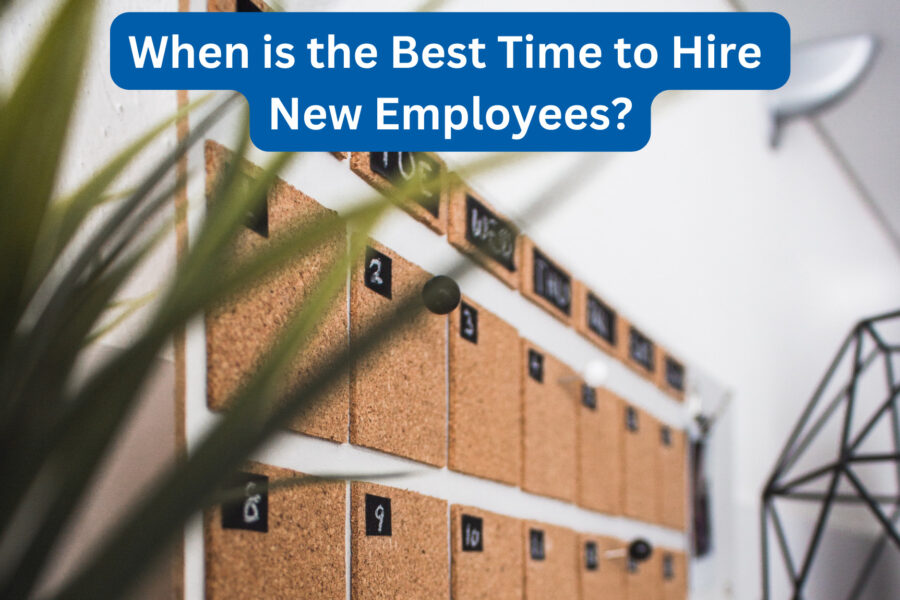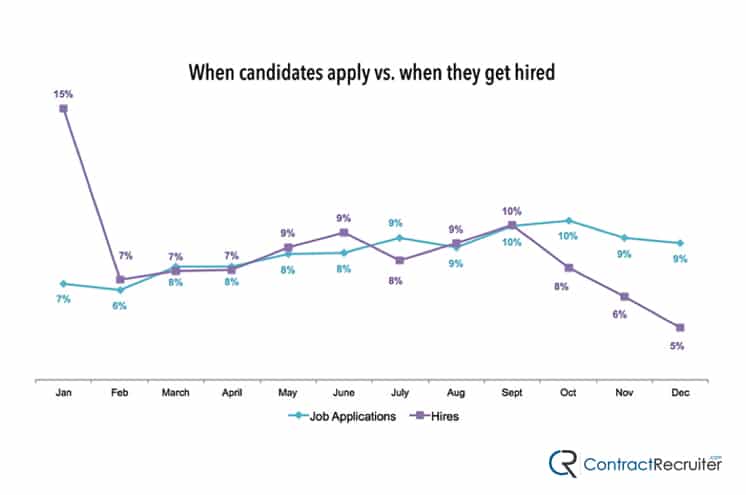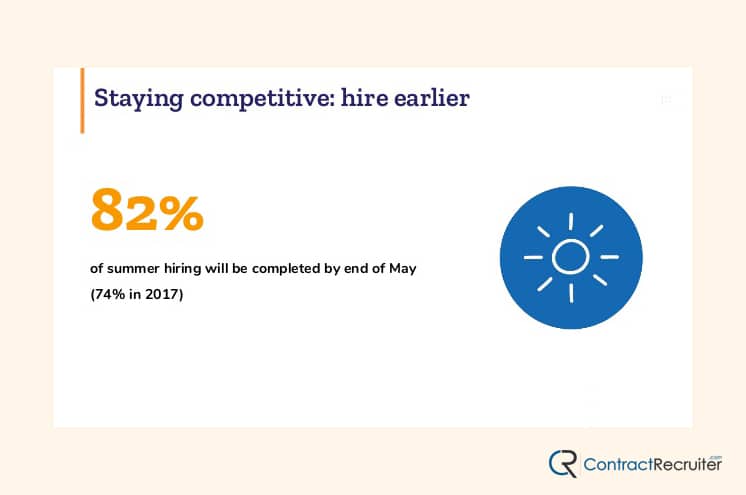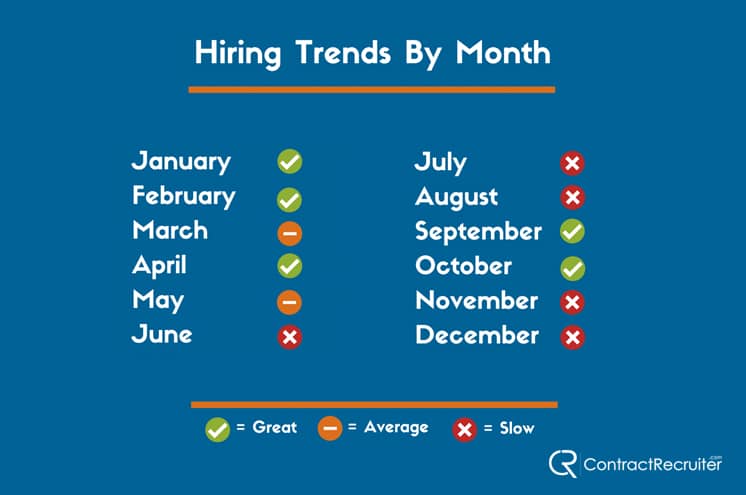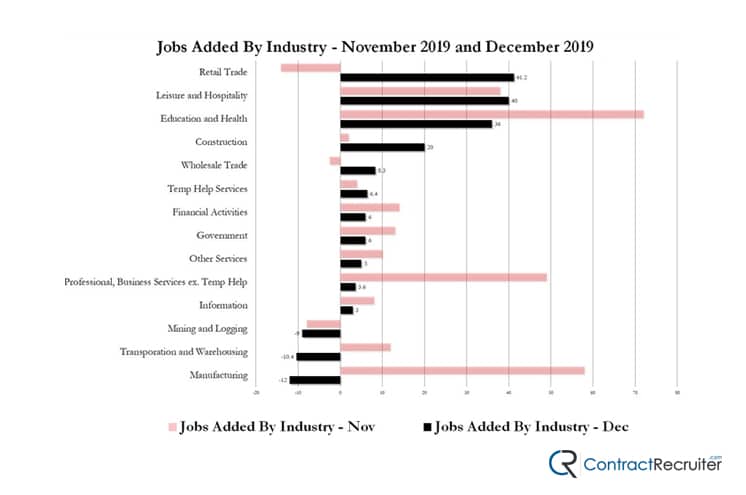Some companies treat hiring as a fickle, variable process. A position opens up, they put out a job ad for it, they hire the best candidate that comes along, and repeat the whole process when it happens again.
Other companies treat hiring more like a science. Sociology dictates that there are going to be ebbs and flows in candidate interest. Seasonal trends in both hiring and job seeking can leave you wondering when the best time to hire new employees is.
So, which is better? Hiring at the start of the year, middle of the year, or hiring at the end of the year?
A Simple Answer
The simplest answer is “whichever works best for your company.” If you have roles to fill at the beginning of the year, you shouldn’t wait until the end of the year to hire people; that leaves you with 10+ months of lower productivity, higher stress, and an understaffed workforce. As 37 Signal’s book Rework says, “Hire when it hurts”.
Conversely, if you need to fill open roles at the end of the year, it’s easy to delay to the start of the next year, if various factors line up to make such a delay worthwhile. End of year bonuses, vacations, training, availability of candidates for interviews, and other factors are important in making these end-of-year hiring decisions.
There are also considerations beyond just the start and end of the year. You can also think about the start and end of the fiscal year, or you can think about seasonal trends. There are pros and cons to hiring any time throughout the year, and different companies will view different timing in different ways.
For example, a company like Spirit Halloween does not need to hire employees at the beginning of the year, as they’re only really active for a month each year. The majority of their hiring takes place in September in the lead-up to their roll-out in October, and by the end of November, their business has been put back into cold storage.
There’s no clear best time to hire new employees, only the best time for your business. Instead, let’s go over the considerations each time of year brings.
New Year, New Jobs (January, February)
The beginning of the year is a great time to hire new candidates for long-term positions within a company. It’s also a great time to pick up candidates who are using the excuse of a New Year’s Resolution to seek out a new, better role for themselves.
January tends to be slow for hiring. Companies put out job advertising, and employees decide to look for new jobs, but the two don’t meet and match until February. January also suffers from many workers still returning from holiday vacations, so the job search doesn’t begin in earnest right away.
January is a good time to start figuring out what you’re looking for in a new employee. You’ll generally have the new year budgets and directives coming down the pipe, so you know what you’re working with. You’ll have a fresh allocation for salaries and benefits, you’ll have permission from above to fill roles or expand departments, and you know where you stand with your teams.
The downside here is that January and February also tend to be leisurely for hiring. Companies have a lot of leeway and little time pressure to fill their roles. Candidates have applications out to dozens or hundreds of companies and can take their time receiving and comparing offers. There’s no crunch, for most companies, so hiring is not done quickly. It’s still faster than the holiday season, though.
(Chart from 2016 LinkedIn job application study)
Paul Feeney, a partner with the international auto retailer AutoKineto, explains the surge in January:
“The first quarter of the new year is always a busy time for recruiting because of new budgets starting. Staffers are generally taking less time off this time of year since they’re just coming out of the holiday season, which helps speed up the hiring process in quarter one, as well.”
Some companies prefer to have their new employees starting in January, so they focus on hiring earlier; the previous November and December. Other companies don’t worry about the annual cycle as much, and pro-rate benefits or vacation days.
Springtime’s New Growth (March, April, May)
The end of a dreary winter and the start of the new growth of spring, edging through into summer, is also a time of new growth in hiring. According to a decade of data, both March and May are above-average in terms of hiring rates, or at least in terms of job advertisement volume.
March is the month of urgency hiring. The open roles from the start of the year that have not yet been filled now need to be filled, and there’s no more time left to spend hoping for that perfect candidate to come along.
Where January sees passive candidates becoming active due to resolutions, March tends to see a surge in candidates dissatisfied with a lack of changes in their current roles. The dissatisfaction pushes them to seek out new opportunities. A high volume of candidates seeking new jobs makes this difficult for candidates, but a great time for hiring managers.
The start of the spring is also when many summer-based businesses start their hiring surge as well. Tourism over summer break, summer destinations, beach and watersport equipment; these sorts of industries see a summer surge, so they hire in preparation for it.
Summer’s approach also brings a sense of urgency to late spring. Hiring managers and executives are planning their summer vacations, and they have less time and attention to spend on hiring. They want to get it over with and get people training as soon as possible.
In fact, according to CareerBuilder data, 31% of summer seasonal employers finish their hiring before May, 34% during May, and 20% during June. Anyone looking for a summer job needs to be looking long before summer because hiring for those roles needs to be done early enough to train the employee in time for the summer position.
The Summer Slump (June, July, August)
Summer is one of the worst times to hire unless you’re specifically operating a business with an autumn surge. Many companies require additional employees over winter and the holidays, but that hiring surge doesn’t happen until fall.
By the time summer rolls around, many companies have spent the majority of their HR and hiring budgets, so the flexibility and leeway to hire more have been slashed. Additionally, companies are looking at expenditures and trends and may start to look for cost-cutting measures to balance out their mid-year budgets. Hiring takes a back seat.
(ZipJobs 2017 Hiring Trends Study)
Many firms, this time of year, are starting to look at employee performance data and are preparing for seasonal trends. It’s a time of studying analytics, monitoring data, and waiting. Some hiring might be relevant for suddenly vacated roles and for new hires that didn’t make it through their probationary period, but in general, the volume is low.
On the other hand, this can present an opportunity. Companies that have the flexibility and budget to hire during the summer can pick up candidates with relatively little competition, compared to the higher volume months. The top candidates may not be available, having already found their new roles from earlier hiring surges, but plenty of quality candidates are still on the market.
There’s also a lot of overlap in August. It can just as easily be considered part of the Autumn trends and go in the next section as well. August hiring, particularly the end of August, leads up to winter jobs and end-of-the-year starts.
Harvesting New Jobs (September, October)
Autumn is traditionally another surge in hiring. It’s the time when nearly every company is ramping up for holidays, including the much-vaunted Black Friday and Christmas sales times. While September is still coming out of the doldrums of summer, October is a surge with above-average job listings according to the same job data from above.
Depending on who you talk to, it can take anywhere from four months to two years for a new employee to adjust to their new role and become “fully productive”. If you’re aiming for the shorter end of that scale, hiring in September or October gives you a functioning and adjusted employee at the start of the following year.
Some studies also suggest that October may be the best month to hire new employees. At the very least, it’s among the busiest months for new jobs posted to LinkedIn. Nearly 90% of those jobs are filled within a month, as well.
End of Year Hiring (November, December)
The end of the year is by far the most contentious time to hire new employees. Some people consider it to be the worst time of year. The holiday season means the HR teams, executives, and managers who need to collaborate to hire a new employee are never going to be in the office at the same time. Likewise, holiday demands make it difficult for candidates to make time for interviews, and often the best candidates put their job search on the back burner for the holiday months.
On the other hand, the accepted flexibility of vacation days during the holiday season gives candidates more flexibility. Some people argue that candidates who would suffer in their current job if they were caught interviewing for other jobs can use the holidays as an excuse to slip out without suspicion.
Budget concerns draw a dividing line between types of companies as well. In companies where budgets roll over to the new year, the leftover budget can be saved for a hiring spree in the new year. In “use it or lose it” companies, an end-of-year hiring surge can make use of what remains of a budget to ensure it’s not cut the following year.
The end of the year is also a time when many companies choose to promote internal employees rather than look for new employees to bring in. Internal employees benefit from the new position prior to holiday spending, and it’s easier to recruit for a lower-tier position when the new year surge comes.
“Many companies also pay annual bonuses in December, so a lot of people wait until January to change jobs. Companies expect this, so they look to make new hires in January.”
Current Events and Other Factors
The global pandemic has created a new landscape for hiring. At first, the pandemic made the hiring market a lot slower. Many companies were cutting back on all spending, making it difficult for candidates to find a job. Nowadays, the hiring market is back to normal.
Some traditional surges, like the back to school end-of-summer surge, are in flux, as the state of education is unknown. Unemployment remains high, giving companies their choice of candidates, but remote work is virtually required for many candidates to even apply.
It’s always worth mentioning, as well, that just because a month isn’t “the best” time to hire doesn’t mean you shouldn’t hire. There are no months where hiring is cursed. If you have a role open up and you need to hire someone for it, hire someone.
In fact, it might even be rewarding to work against the grain and hire during slow months. The cost of hiring is determined, in part, by the competition on sites used to list job advertisements. Anywhere an ad auction is involved, the amount of competition is going to be a strong factor in how expensive it is.
Another factor to consider is cultural norms. Much of what is written above is relevant primarily from a United States perspective. Companies with an international or global presence, including offices in other countries, will have different schedules, different routines, and different norms to consider. Christmas isn’t as big a deal elsewhere, for example, and the end-of-year hiring surge is less disrupted by expected vacations and travel.
Conclusion
The optimal time to hire new employees depends on your company’s specific needs. Seasonal trends and market dynamics can guide timing, but ultimately, hiring should align with your organization’s growth and productivity goals. Flexibility and adaptiveness are crucial, especially in response to changing global conditions like the pandemic.
The right hiring decision balances external opportunities with internal requirements, ensuring the best fit for your company’s future.
In the end, it all comes down to what works best for your company. Hire when you need to hire and when you find a compelling candidate to fill a role.
Ready to optimize your hiring strategy? Stay ahead of the curve by understanding the best times to recruit new talent. Contact our team today to start transforming your hiring process today!
Page updated on December 20, 2023.

